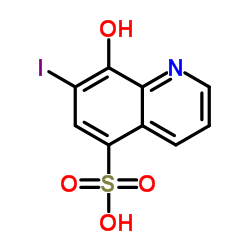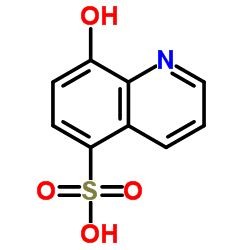Chiniofon

Chiniofon structure
|
Common Name | Chiniofon | ||
|---|---|---|---|---|
| CAS Number | 547-91-1 | Molecular Weight | 351.12 | |
| Density | 2.2±0.1 g/cm3 | Boiling Point | N/A | |
| Molecular Formula | C9H6INO4S | Melting Point | 269-270 °C (dec.)(lit.) | |
| MSDS | Chinese USA | Flash Point | N/A | |
| Symbol |

GHS05 |
Signal Word | Danger | |
Use of ChiniofonFerron (8-Hydroxy-7-iodo-5-quinolinesulfonic acid) has antiseptic and antifungal activity. Ferron can prevent skin and mucosa bacterial irritations and inflammations[1]. |
| Name | Chiniofon |
|---|---|
| Synonym | More Synonyms |
| Description | Ferron (8-Hydroxy-7-iodo-5-quinolinesulfonic acid) has antiseptic and antifungal activity. Ferron can prevent skin and mucosa bacterial irritations and inflammations[1]. |
|---|---|
| Related Catalog | |
| References |
| Density | 2.2±0.1 g/cm3 |
|---|---|
| Melting Point | 269-270 °C (dec.)(lit.) |
| Molecular Formula | C9H6INO4S |
| Molecular Weight | 351.12 |
| Exact Mass | 350.906219 |
| PSA | 95.87000 |
| LogP | 0.38 |
| Index of Refraction | 1.776 |
| Stability | Stable. |
CHEMICAL IDENTIFICATION
HEALTH HAZARD DATAACUTE TOXICITY DATA
|
| Symbol |

GHS05 |
|---|---|
| Signal Word | Danger |
| Hazard Statements | H314 |
| Precautionary Statements | P280-P305 + P351 + P338-P310 |
| Personal Protective Equipment | Eyeshields;Faceshields;full-face particle respirator type N100 (US);Gloves;respirator cartridge type N100 (US);type P1 (EN143) respirator filter;type P3 (EN 143) respirator cartridges |
| Hazard Codes | C: Corrosive; |
| Risk Phrases | R34 |
| Safety Phrases | S26-S36/37/39-S45 |
| RIDADR | UN 2585 8/PG 3 |
| WGK Germany | 2 |
| RTECS | VC2800000 |
| Packaging Group | III |
| Hazard Class | 8.0 |
| HS Code | 2933499090 |
|
~% 
Chiniofon CAS#:547-91-1 |
| Literature: Chim. farm. Promysl., , p. 109 Chem. Zentralbl., , vol. 106, # II p. 3105 |
| HS Code | 2933499090 |
|---|---|
| Summary | 2933499090. other compounds containing in the structure a quinoline or isoquinoline ring-system (whether or not hydrogenated), not further fused. VAT:17.0%. Tax rebate rate:13.0%. . MFN tariff:6.5%. General tariff:20.0% |
|
Hydroxyl radicals cause fluctuation in intracellular ferrous ion levels upon light exposure during photoreceptor cell death.
Exp. Eye Res. 129 , 24-30, (2014) Iron accumulation is a potential pathogenic event often seen in age-related macular degeneration (AMD) patients. In this study, we focused on the relationship between AMD pathology and concentrations ... |
|
|
Proton-transfer compounds of 8-hydroxy-7-iodoquinoline-5-sulfonic acid (ferron) with 4-chloroaniline and 4-bromoaniline.
Acta Crystallogr. C 63(Pt 7) , o405-7, (2007) The crystal structures of the proton-transfer compounds of ferron (8-hydroxy-7-iodoquinoline-5-sulfonic acid) with 4-chloroaniline and 4-bromoaniline, namely 4-chloroanilinium 8-hydroxy-7-iodoquinolin... |
|
|
Polyaluminum chloride with high Al30 content as removal agent for arsenic-contaminated well water.
Water Res. 46(1) , 53-62, (2012) Polyaluminum chloride (PACl) is a well-established coagulant in water treatment with high removal efficiency for arsenic. A high content of Al(30) nanoclusters in PACl improves the removal efficiency ... |
| 7-iodo-8-hydroxyquinoline-5-sulphonic acid |
| 7-iodo-8-hydroxyquinoline-5-sulfonic acid |
| Chinoiodine |
| quiniophen |
| Chinoiodin |
| UNII-6E8Y02XFEI |
| meditrene |
| EINECS 208-938-4 |
| 8-hydroxy-7-iodoquinoline-5-sulfonic acid |
| ferron |
| CHINIOFON ACID |
| 5-Quinolinesulfonic acid, 8-hydroxy-7-iodo- |
| LORETIN |
| m-Iodo-o-hydroxyquinolineanasulfonic Acid |
| MFCD00006793 |
| 7-Iodo-8-hydroxyquinolinium 5-sulfonate |
| 8-hydroxy-7-iodoquinolinium-5-sulphonate |
| 8-Hydroxy-7-iodo-5-quinolinesulfonic acid |
| Chiniofon |
| yellon |
| 8-hydroxy-7-iodoquinoline-5-sulphonic acid |
| Quiniofon |
| 7-Iodo-8-Hydroxychinolin 5-Sulphonic Acid |


